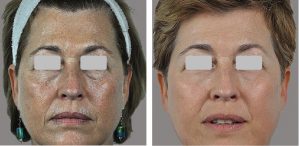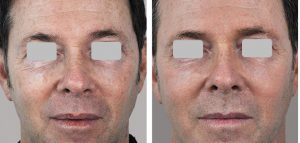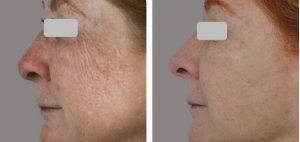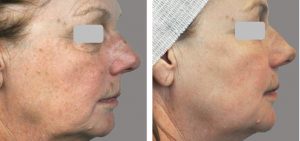CONTACT US

Treatment of aging skin using the SharpLight OmniMax “Stacked” multiple modality platform

Introduction
Background: Lasers have proven extremely effective in the treatment of a variety of cutaneous skin concerns including, pigmented lesions, vascular lesions, rhytides, and skin laxity, among others. Originally developed as single wavelength treatment platforms, lasers were generally limited to targeting one chromophore at a time. With breakthrough advances in technology, however, treatment of multiple chromophores can be achieved with one system that incorporates several lasers and light source wavelengths into one design. One such system is the SharpLight OmniMax, a device that enables the delivery of a stacked modality treatment within a single session. Applying multiple treatment modalities in one sitting can deliver better results over a single modality treatment regimen. This is particularly true when treating photoaged skin, a condition which is characterized by a variety of lesions that preferentially respond to different wavelength light sources.
Objective: To evaluate the effectiveness of the SharpLight OmniMax device at treating photo aged skin, which is a condition composed of multiple concerns that affect the skin.
Methods: The SharpLight OmniMax device was used to treat 10 patients with photo aged skin. Patient selection criteria was designed to target patients exhibiting a wide range of photo aging characteristics. Specifically, each patient included in the study presented with static lentigines, dynamic lentigines, rhytides, skin laxity, dyschromia, and telangiectasia. 4 treatment sessions were undertaken on every patient with 2-3 weeks between each sitting. Using only the multimodality OmniMax platform, three types of treatments using three different modalities were used at each session. All treatments included intense pulsed light with cut off filters 580nm and/or 535 nm, followed by an infrared treatment and then an Erbium YAG 2940 nm resurfacing treatment, which were administered in that order every time.
Results: Patients reported an improvement in texture, tone, color, and wrinkles. 100% expressed an improvement in the overall look of their skin. Review of before and after photographs also demonstrated an improvement in lentigines, dyschromia, telangiectasia and fine lines.
Conclusion: Stacked modality treatment sessions using the SharpLight OmniMax device to simultaneously treat the many signs of photo aged skin is an effective approach. This one platform enables the simultaneous treatment of lentigines, telangiectasia, rhytides, and dyschromia in a single treatment session. The multiple modalities provided by the SharpLight OmniMax device enable a more efficient and rapid delivery of treatment, which increases convenience for the patient. Additionally, more efficient treatment times allow physicians to optimize their time management practices, which helps reduce costs for all involved.
Introduction
Lasers used to treat skin conditions were originally designed around a single wavelength, which generally was used to treat one chromophore or target molecule. Because of this physical limitation,each device based on a laser was only able to treat a small group of issues associated with that particular chromophore. In actual clinical practice however, patients with photo aging often present with a variety of issues that span multiple chromophoric groups2,3. For example it is common to see patients whose photoaging skin includes lentigines, telangiectasia, fine lines and lack of elasticity. Historically, adequate treatment of these issues would involve a regimen requiring the use of multiple lasers, applied at different times, sometimes days apart, in different geographical locations in a clinic. The typical patient experience, therefore, would consist of several visits to the clinic and a prolonged wait time before the final result was achieved.
After the successful introduction of lasers, other light sources were developed that used multiple cutoff filters to deliver different energy wavelengths. Generally these light sources were used to treat non-ablative target chromophores, which led to patient recovery times that were minimal or non existent. In addition, this technology was advanced even further by the development of handpieces with internal cooling capability that enabled cooling of the skin before, during, and after energy was applied. Cooling of the skin protected the epidermis and upper layers of the dermis, which in turn allowed the delivery of higher fluences, while decreasing the risk of injury.
The SharpLight OmniMax was the device used in this study and it is compatible with a number of IPL (Intense Pulsed Light) hand pieces. To improve skin texture including static rhytides an SR 580 nm handpiece is recommended. Another option included in the system is the VP 535nm dual filter hand piece has, which an initial peak of 535 nm -680 nm and a second peak between 860 nm and 1200 nm. These dual hand pieces enable the treatment of vascular pathologies like telangiectasia, generalized erythema, flushing and blushing associated with rosacea vulgaris, as well as the isolated vascular lesions coincident with solar elastosis, and poikiloderma of Civatte. In addition, the ability to specifically choose filters allows the treatment of pigmented lesions such as lentigines, ephelides and other melanotic lesions.
The SharpLight OmniMax system also includes a proprietary feature called Dynamic pulse Control (DPC) to allow variability in settings. DPC optimizes the light pulse configuration for specific skin pathology as well as the various Fitzpatrick skin types and grants the practitioner more control by providing the ability to adjust the fluency, pulse duration, interpulse delay, and contact cooling periods.
Infrared technology included in the SharpLight OmniMax system has been demonstrated to create heat in the dermis which promotes collagen remodeling. In the SharpLight OmniMax system this is accomplished using the “Max IR” handpiece, which leads to immediate skin tightening and new collagen production. As part of its design, an integrated thermoelectrically cooled sapphire window, controls the surface temperature of the skin during treatment which maintains patient comfort.
The resurfacing component of the SharpLight OmniMax is an Erbium YAG 2940 fractional laser which allows the specific tissue ablation associated with limited residual damage. In contrast to ablative resurfacing, fractional resurfacing accelerates post treatment wound healing by leaving areas of intact skin. Clinically this leads to transient erythema, rapid healing and minimal downtime.
Bringing all of these treatment modalities together in the SharpLight OmniMax system should enable a stacked modality treatment method that includes the unique DPC, the Max IR infrared and the Erbium YAG 2940 nm fractional resurfacing. This stacked modality method in turn should provide patients with a treatment experience that improves pigmented and vascular lesions, skin tightening and textural improvement in a single convenient session. The SharpLight OmniMax system, therefore, promises to enable patients and practitioners to obtain results in a shorter period of time with significantly less logistical coordination and effort.
Patients and Methods
10 patients (9 females and one male) were treated in this study. Patient age ranged from 48 to 62 and the group included representatives from skin types I-IV.
Patient Inclusion Criteria:
Clinical signs of facial photo aging were the recruitment criteria for the study. In addition to subjective concerns patients had about their appearance, signs of photo aging including rhytides, both static and dynamic, lentigines, dyschromia telangiectasia and skin laxity were clinically confirmed in all patients. Each participant understood the nature of the treatment, as well as, the potential benefits and risks.
Patient Exclusion Criteria:
Patients were excluded for; tanning within a 6 week period, oral isotretinoin or acetretin within 6 months, a history of hypertrophic or keloid scarring and photosensitivity disorders or taking a systemic medication that would cause photosensitivity. Other exclusion criteria consisted of malignant disease, epilepsy, pregnancy or nursing, endocrine disease, systemic lupus erythematosus or other collagen vascular disease, psoriasis vulgaris, hematologic coagulopathy, epidermolysis bullosa or pemphigus vulgaris, or pemphigus folliaceous, or any chronic or acute disease could affect clinical outcome. Patients with a history of oral herpes simplex were given Valcyclovir as herpes simplex virus prophylaxis.
Prior to treatment, photographs were taken using standardized AP and lateral views. Similar photographs were taken at the conclusion of the 4 sessions that composed the study. In preparation for the study patients completed a patient personal data form, received a physical examination, and had a medical history recorded. The diagnosis was discussed with each patient and informed consent was obtained after a careful discussion of the benefits and possible risks of the treatment plan and procedures.
Treatment Protocol
During this study the SharpLight OmniMax device was used to deliver all treatments. Prior to full face treatment, a test spot was exposed using the 580 nm headpiece light device to determine optimal fluence, pulse duration and pulse configuration parameters resulting in mild erythema without adverse effects. All patients tolerated the test dose well. After test spot success, each patient was started on the actual treatment regimen with the SharpLight OmniMax device, which was used to perform all procedures. The treated areas for all patients were confined to the face and neck and consisted of 4 treatments sessions during which each patient received 3 different treatment modalities. The first was intense pulsed light using cutoff filters of 580 nm and/ or 535 nm depending on patient presentation and response to previous treatment. 3 passes of DPC were done each session. Clinical endpoints for each patient were mild erythema. The settings for each patient were individualized but ranged from 10-21 j/cmA?. Specific settings for each patient can be reviewed in chart 1.
Following the DPC treatment, SharpLight OmniMax infrared (IR) treatment was undertaken using energy levels between 20-30 j/cmA? with precooling and post cooling technology. Three passes of IR were performed during each treatment session and patient feedback was obtained during treatment which allowed the pre and post cooling parameters to be adjusted accordingly. The on time and cooling time for each patient were individually derived based on subjective and objective tissue response by the patient to the treatment.
Finally an ablative procedure was performed, using the SharpLight OmniMax Erbium: YAG 2940nm fractional laser. The micro peel technique consisted of two passes of the fractional laser, with parameters set at: 3 Hz, 1.2 ms and 1.2 j/cmA? with a 9.5 mm x 9.5 mm spot size.
Upon completion of the SharpLight OmniMax treatment, a cold compress was applied according to patient comfort and necessity. Treatments sessions were scheduled 2-3 weeks apart and after each treatment session, follow-up calls were made to patients between 24 hours to 48 hours to assess response to treatment and address any questions.
Results
After each SharpLight OmniMax treatment and follow up visit, patients were evaluated on their subjective experience to the treatment regimen. Subjects were asked to grade their experience with the procedure as well as their results. The satisfaction scale was a four point scale: 1 – Very satisfied, 2 – satisfied, 3 – somewhat satisfied, 4 – not satisfied.
Subjectively, 100% of patients reported an improvement in tone, texture and color, as well as, an improvement in the overall look of their skin. Scores from the four point scale revealed 8 patients who were very satisfied, 1 patient who was somewhat satisfied and one patient who was satisfied. 90 % of patients were satisfied to very satisfied.
Recommendations
To maximize results with the SharpLight OmniMax, pretreatment and post treatment protocols were established.
Pretreatment protocol
Pretreatment preparation includes the avoidance of ultraviolet radiation, prophylaxis in appropriate patients for herpes simplex virus and education regarding expectations.
Post Treatment Protocol
Patients were instructed to apply a bland moisturizer in the first 24 hours and then begin to wash with a mild liquid non foaming cleanser after 24 hours. Retinol, vitamin A acid and its derivatives, glycolic, mandelic, lactic and salicylic acids were all to be avoided for 48 hours post treatment. Patients were also advised to avoid picking or any manipulation of the face during the healing period. A sunscreen of SPF 30 or higher with both UVA and UVB coverage was applied for 24 hours after each treatment.
Conclusion
Unlike single modality treatment platforms, the SharpLight OmniMax incorporates multiple modalities in one system, which enables patients to see better, faster results. Additionally, an improved efficiency is gained for the physician by reducing the time required for treatment, the investment required for equipment, and the physical clinic space needed to provide first rate services.
The SharpLight OmniMax device achieves better and faster results for aging skin through the use of a stacked modality treatment regimen that addresses the multiple skin concerns within a single session. The system includes the proprietary DPC technology, a Max IR infrared and an Erbium YAG 2940 nm fractional treatment, which enables this kind of versatility in treating the variety of signs and symptoms associated with aging skin.
Results of this study, which employed the stacked modality treatment regimen, showed that 90% of patients were either very satisfied, or satisfied with their treatment experience. 100% of patients stated their level of satisfaction was high enough that they would recommend treatment to others. In addition to being effective with 100% of patients seeing improvement in skin tone and color, the treatment led to no adverse side effects.
The SharpLight OmniMax device is compatible with a wide range of hand pieces, each with a multitude of treatment parameter options. In this study, multiple hand pieces were used including a DPC hand piece, a Max IR infrared hand piece and an Erbium YAG 2940 nm hand piece. The thermoelectric cooling mechanism of the SharpLight OmniMax system, was also essential in providing comfortable treatment sessions for the patient, while protecting the epidermis.
Overall, the multiple modality regimen has several advantages over single modality treatment systems. One critical advantage is how heat penetrates the skin when multiple modalities are used. Combining these treatment methods allows for greater heat dispersion to the dermis, which in turn enhances collagen production and remodeling. Furthermore, patients and clinicians see faster results from the various treatments, which can be performed all at once, unlike single modality treatments that are spread out over time.
References
1. Anderson RR, Parrish RR. Selective photothermolysis: precise microsurgery by selective absorption of pulse radiation. Science .1983;220:524-527.
2. Bitter PH. Noninvasive rejuvenation of photo damaged skin using serial, full-face intense pulsed light treatments. Dermatol Surg. 2004;30(9):1196-1200.
3. Weiss RA, Weiss MA, Beasley KL. Rejuvenation of photo damaged skin: 5 year results with intense pulsed light of the face, neck and chest. Dermatol Surg. 2002;28(12):1115- 1119.
Dr. Lisa Kellett is a Dermatologist certified in 1997 in both Canada and the United States. She is the founder and principal dermatologist at DLK On Avenue specializing in cosmetic dermatology and laser surgery. She graduated with Honours at University of Toronto with a degree in Medicine and went on to do an internship and a second year residency in Internal Medicine at the University of Western Ontario. She then completed a Dermatology residency at the University of Toronto. She is a fellow of the Royal College of Physicians and Surgeons of Canada, and a member of the Canadian Laser Aesthetic Surgery Society, the Toronto Dermatological Society and the College of Physicians and Surgeons of Ontario.
Dr. Kellett has extensive experience in the use of medical technology including the development of new technology and has been at the forefront of using cutting edge devices in cosmetic and laser dermatology. Due to her innovation in the field of cosmetic dermatology, she has lectured widely about developments in laser surgery and has been a leader in the industry for over 15 years.
Dr. Kellett has been involved as a consulting dermatologist to laser companies to influence new product development. She has been widely featured also in the media including print , radio, online and television such as Flare, Fashion , Elle , Globe and Mail, Toronto Star, National Post , Ottawa Citizen, Zoomer, Reader’s Digest, Canadian Living, Chatelaine, Huffington Post, Macleans, Now , Elevate, Todays Parent, Alive, Best Health, Glow, Global , CBC, CTV, City TV, Marilyn Denis show, e talk, E! Network, W5, Slice network, ET Canada, Canoe Network among others.
| Random | Gender Age | Treatment Area | # of Tx | Type of Treatment | Parameters Treatment | Parameters Treatment | Parameters Treatment | Patient Satisfaction | Post-Treatment Response |
| #01JT | F 51 | Face & neck | 4 | Combination DPC Infrared Fractional | DPC 580SR Textural msec10-15/fl.13j 1pass Vascular msec10/fl.13-20j 1pass 535VP-LVL msec10-15/fl.15-16j 1pass to cheeks/nose | Infrared Precool 5 sec On time 3 sec Fl.15-20j 2 passes | Fractional 7X7 / 3HZ msec 1.5/1.2j 1-2passes | 3 Somewhat satisfied | Erythema |
| #02DS | F 51 | Face & neck | 4 | Combination DPC Infrared Fractional | DPC 580SR Textural msec15/fl.15-18j 1pass Pigment msec12/fl.16-18 1pass | Infrared Precool 5 sec On time 3 sec Face 30j Neck 25j 2 passes | Fractional 7X7 / 3Hz msec 1.5-3/j 1.5 1pass | 1 Very satisfied | One day of puffiness. Recovery 3 days. |
| #03HL | M 56 | Face & neck (DPC above hairline) | 4 | Combination DPC Infrared Fractional | DPC 580SR Pigment msec12 /fl. 14-18/ 2passes Vascular msec 10/fl. 17 /1 pass | Infrared Precool 5 sec On time 3 sec Face 20j Neck 15j 2 passes | Fractional 7X7 3 Hz msec1.2/ 1.2j 1-2 passes | 1 Very satisfied | Well tolerated |
| #04CW | F 62 | Face & neck | 4 | Combination DPC Infrared Fractional | DPC 580SR Textural msec15-20/fl.12-16 1pass Pigment msec12-15/fl.12-16 1pass Vascular msec 10/fl. 13-16j/cmA? 1pass | Infrared Precool 5 sec On time 3 sec Face 20 j Neck 15j 2 passes | Fractional 7X7 / 3HZ msec1.2/j 1.2 2 passes | 2 Satisfied | Erythema transient throbbing for a few hours |
| #05GA | F 59 | Face & neck | 4 | Combination DPC Infrared Fractional | DPC 580SR Textural msec15/fl.13-16 /1pass Pigment msec12/fl.13-16/1pass Vascular msec10/fl.13-15/1pass 535VP DVP/LVL msec12fl.12-16 to dark brown spot cheeks and nose | Infrared Precool 5 sec On time 3 sec 20-25j 2 passes | Fractional 7X7 3HZ msec1.2/j 1.2 3 passes | 1 Very satisfied | Well tolerated |
| #06AB | F 49 | Face & neck | 4 | Combination DPC Infrared Fractional | DPC 580SR Textural msec15/fl.12-19/1pass pigment msec 15/fl.15-20/1pass vascular msec10-12/fl.15/1pass | Infrared Precool 5 sec On time 3 sec Face 20-15j Neck 15j 2 passes | Fractional 7X7 /3HZ msec1.2/j 1.2 2passes | 1 Very satisfied | Well tolerated |
| #07AP | F 51 | Face & neck | 4 | Combination DPC Infrared Fractional | DPC 580SR Textural msec 20/fl.12-20j 1 pass Pigment msec 12 /fl.12-20 1pass Vascular msec12/fl.12-20 | Infrared Precool 5 sec On time 3 sec Face 25j Neck 20j 2 passes | Fractional 7X7/ 2 HZ msec 1/j 1.2 3 passes | 1 Very satisfied | A�Quite tolerable, erythema that resolved in a 48 hours |
| #08AJ | F 62 | Face | 4 | Combination DPC Infrared Fractional | DPC 580SR Textural msec 10-15/fl.13j 1pass Vascular msec10/fl.13-20j 1 pass 535VP LVL msec 12/fl.17-19 Nose & cheeks | Infrared Precool 3-5 sec On time 2-5 sec 20-25j 2 passes | Fractional 7X7 / 3HZ msec 1.5/j 1.2 2 passes | 1 Very satisfied | Burning sensation immediately after, relieved by ice packs |
| #09PW | F 51 | Face & neck | 4 | Combination DPC Infrared Fractional | DPC 580SR Textural msec10-15/fl.15-21 1 pass Pigment msec10/fl.15-21 1pass Vascular msec10/fl.15 | Infrared Precool 3-5 sec On time 3-5 sec 20-25j 3 passes | Fractional 7X7 3Hz msec1/j 1.2 2 passes | 1 Very satisfied | Transient erythema |
| #010JB | F 55 | Face & neck | 4 | Combination DPC Infrared Fractional | DPC 580SR Textural msec10-15/fl.15-21 1 pass Pigment msec10/fl.15-21 1pass Vascular msec10/fl.15 | Infrared Precool 4-5 sec On time 2-4 sec Face 30j Neck 25j | Fractional 7X7/ 2 HZ msec 1/j 1.2 3 passes | 1 Very satisfied | Discomfort and Transient erythema |
02DS
03HL
05GA
08AJ









